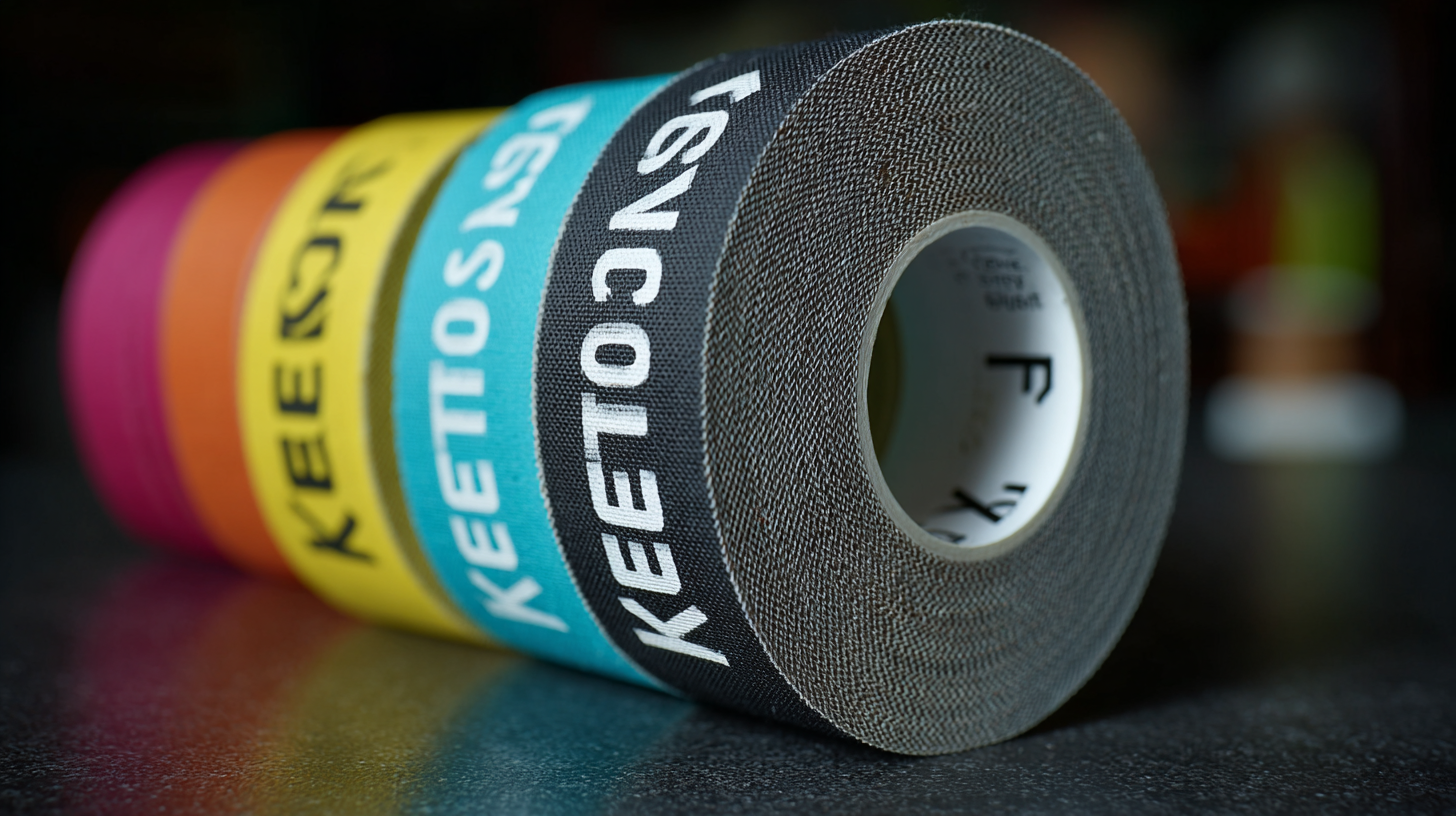Unlocking the Advantages of Using the Best Kinesiology Tape for Enhanced Performance
The increasing popularity of Kinesiology Tape in sports and rehabilitation underscores its significant advantages in enhancing athletic performance and recovery. According to a report by Grand View Research, the global kinesiology tape market is expected to reach over $600 million by 2025, driven by rising awareness among athletes and fitness enthusiasts about its benefits in injury prevention and rehabilitation. Kinesiology Tape provides support to muscles and joints while promoting circulation and lymphatic drainage, crucial for reducing muscle soreness and increasing functional performance.

Moreover, research published in the International Journal of Sports Physical Therapy indicates that Kinesiology Tape can improve proprioception and muscle function, contributing to optimal athletic performance. As athletes continue to seek ways to gain a competitive edge, understanding the benefits and proper application of Kinesiology Tape becomes essential for both professional and amateur sports communities.
Benefits of Kinesiology Tape for Athletes and Active Individuals
Kinesiology tape has gained significant traction among athletes and active individuals for its multitude of benefits in enhancing performance and recovery. According to a report from the Journal of Sports Science & Medicine, up to 25% of competitive athletes utilize kinesiology tape to manage pain, improve proprioception, and reduce muscle fatigue. This elastic tape allows for full range of motion while providing support to muscles and joints, enabling athletes to perform at their peak without the fear of injury.
Moreover, research suggests that kinesiology tape can improve circulation and lymphatic drainage, which are crucial for recovery post-exercise. A study published in the International Journal of Sports Physical Therapy found that applications of kinesiology tape resulted in a 20% increase in blood flow in the taped area, aiding in quicker recovery times and overall performance enhancement. Active individuals, from weekend warriors to elite competitors, can thus benefit from the physiological effects of kinesiology tape, making it a valuable tool in their training regime.
Unlocking the Advantages of Using the Best Kinesiology Tape for Enhanced Performance
| Benefit |
Description |
Target Population |
| Pain Relief |
Helps alleviate pain by lifting the skin and reducing pressure on pain receptors. |
Athletes, Active Individuals |
| Improved Circulation |
Enhances blood flow to affected areas, promoting quicker recovery. |
Injury Recovery, Post-Surgery Patients |
| Support for Joints and Muscles |
Provides stability to joints and muscles during physical activity. |
Recreational Sports Players, Fitness Enthusiasts |
| Reduced Swelling and Inflammation |
Helps in minimizing swelling and inflammation in injured areas. |
Injury Recovery Patients |
| Enhanced Flexibility |
Allows greater range of motion, enabling better performance. |
Athletes, Dancers |
| Increased Awareness of Body Position |
Improves proprioception, helping athletes maintain proper form. |
Competitive Athletes, Coaches |
Understanding the Science Behind Kinesiology Tape Application
Kinesiology tape has gained popularity among athletes and physical therapists alike, but what truly underlies its effectiveness?
At its core, the science of kinesiology tape application revolves around its unique design and how it interacts with the human body.
This elastic tape, when properly applied, mimics the skin’s elasticity, allowing a full range of motion while providing support to muscles and joints.
The tape’s structure facilitates proprioception, enhancing the brain's awareness of body position and movement, which can significantly improve athletic performance and reduce the risk of injury.

Moreover, the application technique plays a critical role in maximizing the benefits of kinesiology tape.
Different taping methods target various injuries and conditions.
For instance, applying tape along a muscle's direction can promote muscle activation or reduce strain, while a configuration that crosses the muscle fibers may help in managing inflammation and swelling.
Understanding the underlying principles of tension, stretching, and skin lifting further allows practitioners to tailor their approach, leading to more effective outcomes for athletes striving for enhanced performance.
Through this precise application, kinesiology tape not only serves as a supportive tool but also contributes to a deeper understanding of bodily mechanics.
Step-by-Step Guide to Properly Applying Kinesiology Tape
Kinesiology tape has gained popularity among athletes and fitness enthusiasts for its ability to support muscles and joints while enhancing performance. Applying kinesiology tape correctly is essential to unlocking its full benefits. In this step-by-step guide, we’ll explore the proper technique for application to ensure optimal results.
First, it’s crucial to clean and dry the skin where the tape will be applied. This helps the tape adhere better and prevents skin irritation. Next, measure the tape against the body part you want to support, allowing a bit of extra length for ease of application. When cutting the tape, round the edges to prevent peeling. As you apply the tape, remember to stretch it according to the required tension—light tension for support and stronger tension for pain relief. Be mindful of the anchor points; tape should be applied without stretching at these areas to allow for natural movement.
After applying the kinesiology tape, it’s important to rub it gently for better adhesion and to activate the adhesive properties. Remind users to avoid applying tape over open wounds or skin conditions and to test for allergies with a small patch before extensive use. With practice, applying kinesiology tape can enhance performance and provide the necessary support to keep you in the game.
Benefits of Kinesiology Tape on Athletic Performance
Common Mistakes to Avoid When Using Kinesiology Tape
When using kinesiology tape for enhancing performance, avoiding common mistakes is crucial to maximize its benefits. One of the most frequent errors is improper application. Ensure that the skin is clean and dry before applying the tape, as any residue can hinder adhesion. Furthermore, cutting the tape incorrectly or stretching it unevenly can lead to ineffective support or even discomfort. It’s essential to personalize the taping technique based on the specific muscle group or injury being addressed, as a one-size-fits-all approach may not yield optimal results.
Another common mistake involves neglecting to consult educational resources or professionals before using kinesiology tape. Many athletes assume they know how to apply the tape, but without guidance, they might misuse it. This can lead to increased pain or additional injuries, especially in sensitive areas like the back or knees. Learning the correct techniques not only enhances recovery but also promotes better overall performance. Always take the time to understand the purpose and method of applying kinesiology tape to fully unlock its potential in your athletic endeavors.
Tips for Choosing the Best Kinesiology Tape for Your Needs
When it comes to choosing the best kinesiology tape for your specific needs, several key factors should be taken into consideration to ensure optimal performance. First and foremost, evaluate the tape's elasticity and thickness. High-quality kinesiology tape should offer a balanced stretch, closely mimicking the elasticity of the skin. This feature allows for better mobility and comfort during physical activities, promoting greater effectiveness in muscle support and pain relief.

Another important aspect is adhesive quality. Look for kinesiology tape with hypoallergenic, skin-friendly adhesives that provide a strong hold without risking skin irritation. The durability of the tape also matters—opt for options that can withstand sweat and moisture while maintaining adherence throughout your workouts or competitions. Lastly, consider the width of the tape; wider tape may be more suitable for larger muscle groups, while narrower options can effectively target smaller areas. By taking these factors into account, you can select the right kinesiology tape that meets your unique performance needs, enhancing both your workouts and recovery.






